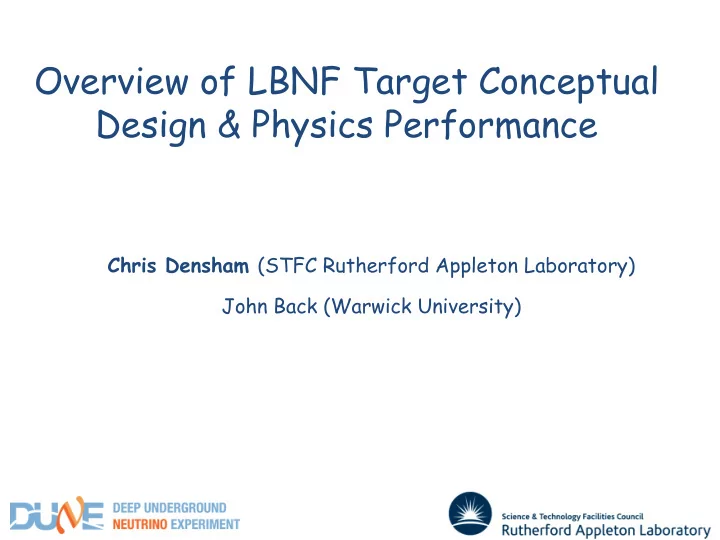

Overview of LBNF Target Conceptual Design & Physics Performance Chris Densham (STFC Rutherford Appleton Laboratory) John Back (Warwick University)
Our starting point: Helium Cooled T2K Target Target installation in magnetic horn using exchanger and manipulator system Chris Densham 2
LBNF helium cooled target conceptual design Horn inner ‘Bafflette’ conductor mini- Graphite collimator ‘Hylen’ target rod device BPM Chris Densham 3
Target Concept Selection Criteria 1 Physics performance Instantaneous physics performance Upgradeability to 2.4 MW Flexibility re optimisation (materials, beam size etc) Compatibility with beam alignment (hadron vs muon?) 2 Engineering performance Safety factor = f(stress, temperature) Lifetime, resilience to radiation damage Resilience to off-normal conditions Resilience to beam trips Potential for diagnostics 3 Impact on other systems Impact on horn/stripline design Ease of integration with horn Ease/reliability of alignment with horn axis Impact on services/plant Ease of remote handling/disposal Impact on TS design Impact on absorber design 4 Cost Cost & resource for design/prototyping Cost & resource for manufacture Cost of RH equipment Disposal cost 5 Schedule Time to design Time to prototype Time to manufacture Schedule impact on other systems 6 Risk Design complexity Ease of manufacture Remote handling complexity Departure from known technology Schedule risk ES&H / ALARA issues
Particle Production Target ‘Optimum’ Performance • λ overall = λ physics × λ reliability , where λ reliability = fn(I, σ ,L…) • For CP sensitivity – small beam σ is favoured • For target lifetime – bigger σ is better. – Lower power density – lower temperatures, lower stresses – Lower radiation damage rate – Lower amplitude ‘violin’ modes (and lower stresses) • For CP sensitivity – long target (c.2m) is better • For max lifetime – short and simple target is better • For integrated optimum performance, need to take both instantaneous performance and reliability into account – E.g. How to achieve best physics performance possible for a target lifetime of a minimum of 1 year? – Answer will depend on beam parameters & power, changeout time etc Chris Densham
Helium cooled target concept selection 1: Single 2.2m long target with remote-docking downstream support 3: Single intermediate length (c.1.5 m) target supported as a simple cantilever 2: Two ~1m long cantilever targets, one inserted at either end of horn Chris Densham 6
Comparison of CP sensitivity for 3 options considered (all r = 8 mm, σ = r/3 To achieve same 3 σ exposure for CP sensitivity as 2.2 m long target: 1.5 m cantilever needs to • run extra 19 days/year 1.6 m cantilever needs to • run extra 13 days/year Ultimate objective: ‘As • Long As Realistically Achievable’ cantilever target Chris Densham 7
CP sensitivity for 1.5 m cantilever target vs target & beam rms radius Comprehensive • study of physics performance for range of beam and target radii Need to • compromise between physics and engineering performance Some scope to • improve CP sensitivity for given beam rms radius Chris Densham
LBNF conceptual design compared with current ‘state-of-the- art’ T2K@1.3 MW NB current experience up to 500 kW LBNF@1.2 MW Chris Densham 9
Beam based alignment During initial alignment (without baffle): Use low intensity beam scans (horizontal and vertical) to: 1. Find outer edges (therefore centre) of bafflette (25% interaction through bafflette) – Bafflette easily distinguishable from target – 2. Find outside edges (therefore centre of mass) of target (75% transmission vs 2% transmission through 4 λ target) – 3. Bafflette centre and target centre gives target angle 10 10
Incorporation of ‘Hylen device’ (beam position monitor) Provides target • upstream location at full beam intensity Fermilab to • supply physics design and Be components RAL to supply • engineering design and other mechanical parts Thermocouples attached to ends of 3x3 RAL to • array of beryllium rods integrate with target and serves as online Beam Existing remote handling Position Monitor NuMI design Chris Densham 11
Charge Q3: Integration of target and bafflette in MARSLBNF Impact of target on other systems (e.g. Hadron Absorber) well understood by LBNF project team at Fermilab (Reitzner, Mokhov, Striganof) Chris Densham 12
Charge Q3 (contd): Screenshot of a bi-weekly Technical Coordination Meeting on Zoom
Target system: outline work plan (charge Q2) 1. Develop preliminary design for 1.5 m long helium cooled graphite target system Develop 3D CAD design informed by FLUKA, ANSYS CFX and – thermal/mechanical FEA in iterative process Identify realistic manufacturing and joining methods – Carry out critical feature prototyping – 2. Generate outline specification for helium cooling circuit (with some overhead for longer target) Develop helium circuit conceptual design (Fermilab have already • started) 3. Preliminary design of target support, services & horn integration 4. Preliminary design of target exchanger (for up to 1.84 m long) 5. Final design for 1.5 m long target (c.2022) 6. Construct 1 st full prototype ~1.5 m long target (ideally a viable backup) 7. R&D towards construction of first operational ‘As Long As Realistically Achievable Cantilever Target’ (c. 2026) Chris Densham 14
Charge Q1 • Onto the rest of the talks… Chris Densham 15
Recommend
More recommend